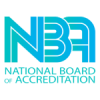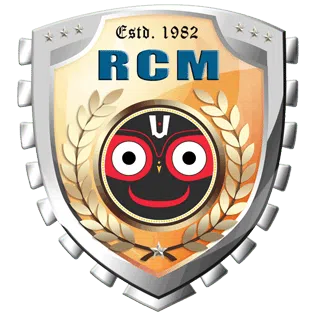Written By, Dr. Hemant K Panda || Annjaan Daash
Dr. Hemant K Panda: Professor and Principal, Regional College of Management, Bhubaneswar
Annjaan Daash: Head Training and Placement, Regional College of Management, Bhubaneswar
Abstract
Six Sigma is a disciplined, data-driven approach and methodology for eliminating defects in any process- from manufacturing to trading, and from product to service. There is a lot of interest in deploying Six Sigma to sales and marketing to reduce the uncertainty inherent in it. Many organizations such as 3M, Allied Signal, Dell HSBC, Johnson & Johnson, LSI Logic, Owens Corning, Service Master, Standard Register (Taylor Communications), etc. have deployed Six Sigma in sales and marketing and have achieved significant growth- both in top-line and bottom-line performance.
This research elaborates Six Sigma DMAIC Methodology (Define, measure, analyze, improve, and control) in Sales and Marketing and provides various frameworks for its successful deployment to achieve competitive advantage.
Keywords- Six Sigma, DMAIC, Methodology, Sales, Marketing, Competitive Advantages.
Introduction
The Greek letter sigma ( ) is used in mathematics to represent standard deviation (i.e. how much a process varies from its average value). A sigma quality level offers an indicator of how
often defects are likely to occur, whereby higher sigma quality levels indicate a process that is less likely to create defects as the quality level also increases accordingly. Under the Six Sigma methodology, deficiencies are described in terms of ‘defects’ per million opportunities, with a score of Six Sigma quality level equal to 3.4 defects per million opportunities (DPMO).
Here an ‘opportunity is defined as any chance for non-conformance or not meeting the required specifications. Six Sigma is a disciplined, data-driven approach and methodology for eliminating defects in any process- from manufacturing to trading, and from product to service. It was originally developed at Motorola in the 1980s for production processes characterized by high volume and a high degree of standardization with the goal of eliminating waste by achieving near-perfect results.
In a current business environment characterized by changing buyer preferences, channel leverage, shorter product life cycles, and increased financial pressure on sales growth, profits, and shareholder value, there is a lot of interest in deploying Six Sigma to sales and marketing to reduce the uncertainty inherent in it. Six Sigma has been applied by various organizations in their sales and marketing processes with the ultimate goal of increasing customer satisfaction, sales revenue, market growth, and profitability. Organizations such as 3M, Allied Signal, Dell
HSBC, Johnson & Johnson, LSI Logic, Owens Corning, Service Master, Standard Register (Taylor Communications), etc. have deployed Six Sigma in sales and marketing and achieved significant growth in top-line and bottom-line performance.
Six Sigma Evolutions: Various Generations
The initial focus of Six Sigma was the rigorous process of defect reduction in manufacturing operations and was termed as Generation 1 of Six Sigma. Later many companies applied Six Sigma to service processes for controlling variability and experienced bottom-line benefits. In this phase of Six Sigma, the focus was on cost reduction and economics and was termed Generation II.
Research has shown that most of the service processes are performing at less than 3.5 Sigma quality level with a defect rate of over 23,000 DPMO or yield 97.7 (Yilmaz and Chatterjee, 2000). If the Sigma quality level is increased to 4.5 Sigma quality level, the defect rate will be dropped significantly to 1350DPMO. This clearly indicates a 17–fold improvement in process performance as the process yield will be increased to 99.9 percent (Madhani, 2016).
Process improvement methodologies such as Six Sigma deployment in services would bring significant financial returns to the organizations (Antony, 2006). In manufacturing processes and services, usually there are very high correlations between the quality of process inputs and the outputs, thereby making operation predictable, and fact-based and thus enabling the smooth deployment of Six Sigma.
Figure 1: (Six Sigma Evolution: Various Generations
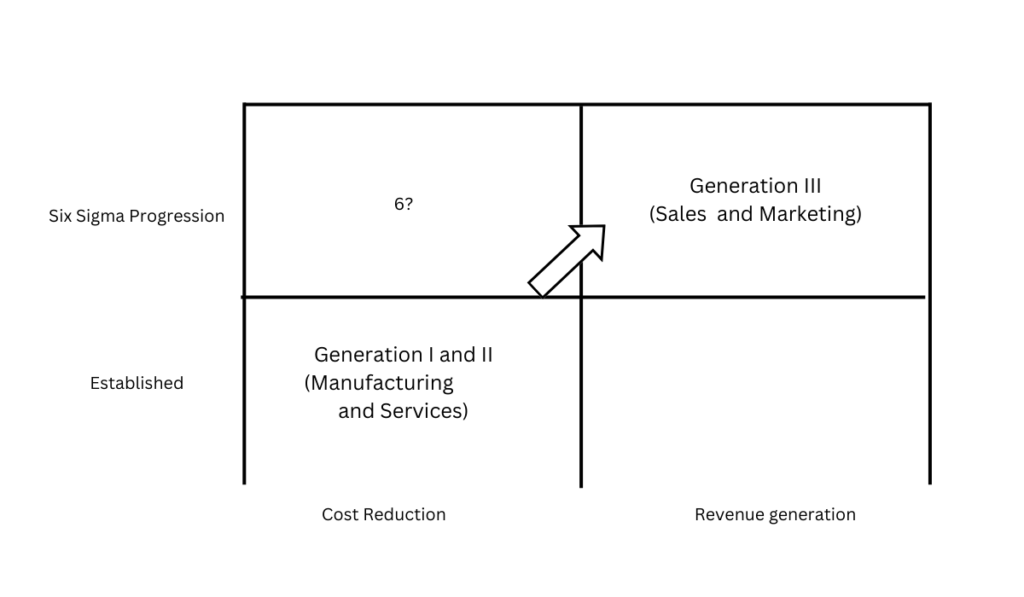
Six Sigma Focus
(Framework developed by the author)
Generation III of Six Sigma focuses on a transactional process to reduce its variability and includes its application to sales and marketing. Transactional processes that require high human input avoid control as process inputs and outputs are weakly correlated. Hence, in sales and marketing, the linkages between inputs and outputs are simply not as easy to adjust as they are in manufacturing processes and hence proven to be the most difficult for Six Sigma deployment. As generations I and II projects have internal objectives of defeat reduction and cost cutting, the transition from I and II is easy. However, Generation III has external, objectives of increasing effectiveness, enhancing value creation, and boosting top-line revenue; hence its
deployment is still evolving (Figure I). Although applications of Six Sigma in sales and marketing are not common, it provides great potential for huge benefits (Pestorius, 2006).
Six Sigma Deployment in Sales and Marketing: DMAIC Methodology
Six Sigma is a business improvement program that targets process variation and traditionally bit has been used in manufacturing to reduce defects. Now companies are using Six Sigma to improve sales, marketing, and customer support. Pestorius (2007) noted that Six Sigma could improve sales and marketing to attain a state of sustainable growth by positively influencing marketing’s three process areas viz. strategic, tactical, and operational (Creveling et al., 2006).
Hence, to move up the competitive ladder, organizations need to deploy Six Sigma to enhance sales and marketing performance. Such projects use standard Six Sigma DMAIC methodology (define, measure, analyze, design, and verify) applies.
Six Sigma DMAIC Methodology
The Six Sigma DMAIC methodology along with major drivers for its successful deployment is shown in Figure 2
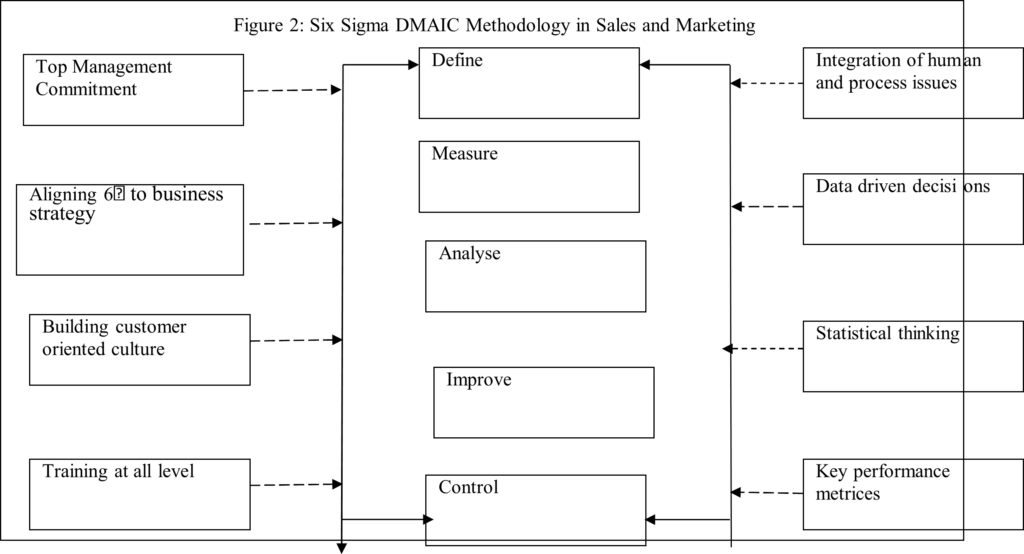
(Framework developed by the author)
Following are various stages of DMAIC
- Define: What is that the sales department is seeking to improve? This stage defines the goals and customer requirements.
- Measure: How is the sales process measured? What is the current capability of the process? How is it performing in terms of variability? This stage measures the process to determine current performance.
- Analyse: What are the most important causes of sales-related problems? How to map the process and priorities for action? This stage analyses and determines the root causes of the variability.
- Improve: How does the sales department remove the causes of problems (i.e. defects)? How do they re-engineer the process and simplify it? This stage improves the sales process by eliminating defects.
- Control: How can the sales department maintain the improvements? What are various statistical processes that control future process performance?
Six Sigma focuses on identifying customer needs and expectations and translating these into critical to quality (CTQ) service characteristics. This is expected to have great impact on customer satisfaction and loyalty by deployment through specific process improvement stages.
These stages are explained in detail below:
Define
The first state in Six Sigma methodology is the define stage. Define stage begins by identifying and prioritizing the products/markets that offer the sales the greatest options for growth. It is mainly because not all market opportunities are worth an investment. The opportunities must be evaluated using a quantifiable approach and not one driven by guesses, agendas or intuition.
Define state identifies the sales problem addressed, the customers being affected, what they view as important, and what performance matrices will be used. Sales goal, scope, expected outcome, boundaries and project schedules are specified in define stage. Sales problems (i.e. problem statements) are defined clearly and as much possible as numerical. After the sales activities are identified, they are assigned to process improvement.
The define stage focuses on the defining the core business process influencing the customer (i.e. Voice of Customer (VOC)) that have the highest priority for improvement. Without this information, few sales efforts can satisfy either the effectiveness or efficiency criteria that are so important in sales success.
Measure
This stage measures the capability of the existing sales process and focuses on the performance of the core business process involved. The measure stage determines what processes are potentially creating to the problem, develop a data gathering plan and system, collect data to determine the types of matrices and validate how the information (data) will be used to drive business decisions. This stage identifies sales performance measures such as cost, efficiency, and service levels while focusing on problem areas. It also emphasizes on defining value for the targeted markets identified in the define stage. Because the definition of value changes from one product/market to the next, it captures the Voice of the Market (VOM), which provides the competitive intelligence necessary to make informed decisions.
Analyse
The Analyse stage used statistical tools and techniques to narrow the list of possible causal elements to those that contribute the most to the sales problem and find the root causes when and problem occur. Analyse stage requires the learning of new tools, matrices and their application in sales. Careful analysis of sales performance, allow the company to analyze many relevant issues:
- At what point leads are lost by sales people and reasons thereof.
- Source of variability in qualification criteria for prospects, follow-up, and pricing.
- Defects in the sales processes that result in lost sales and wrong prospects targeted.
- The customers of the company who have purchased before and have not purchased again.
- Impact of less effective sales promotion efforts in terms of opportunity costs.
Improve
This stage consists of identifying and prioritizing improvement areas. The purpose of continuous improvement is to reduce the amount of common cause variations in the sales processes. Improve stage develops plans to change the sales process involved to eliminate or reduce the effect of the root causes of variations. It involves testing these plans, determine whether the solution is able to reduce variations, establish their efficacy, and then implement changes so that the overall sales performance can be improved. Statistical methods are used to validate the improvements. After this testing, the improvement should be implemented throughout the process.
Control
In this last stage, focus is to eliminate the causes of problems and to maintain the continuity in sales process improvement. Control stage maintains changes made to the sales process and monitor process performance to determine whether it is in control. If the process is in control, the standards of cost, efficiency, and services are set to those of the improved process. Hence this stage identifies the controls that must be in place to sustain the benefit of the new process.
Six Sigma Deployments:
Enhancing Competitive Advantages
While manufacturing costs have been squeezed effectively without compromising quality, sales and marketing operations have not seen comparable increases in efficiency as well as effectiveness. For customer facing functions such as sales and marketing, defect is a flaw in a process that results in a lower level of customer satisfaction or a lost customer.
By measuring how current and potential customers define value and then building processes around delivering that value- the ultimate result is greater customer satisfaction, trust and loyalty.
Long term customer relationship and higher customer retention positively impact revenue and profitability growth. With Six Sigma deployment in sales and marketing, sales cycle times can be reduced, and service can produce better results (for example, less customer defections).
Six Sigma can be used to improve both the quality and efficiency of the sales function (calabro, 2004). As shown in Figure 3, Six Sigma deployment in sales and marketing improves efficiency and effectiveness of internal as well as external processes and thereby enhances competiveness of the firm.
Figure 3 Six Sigma Deployment: Enhancing Competitive Advantages
- Increase revenue, market share, and profitability
- Improve the competitiveness of the firm
- Enhance customer value proposition
- Higher customer satisfaction and retention
- Process efficiency and effectiveness focus
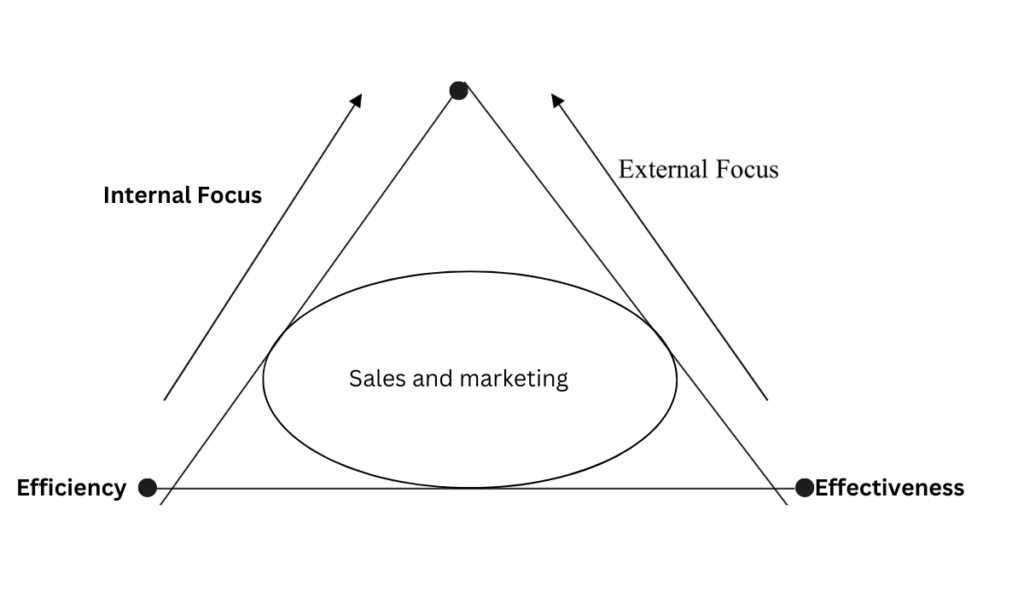
-Effective Sales forecasting – Sales force effectiveness
-Higher Programme yields -Service level improvements
-Reduce cycle times – New product introduction
– Better qualified leads – Order completeness and correctness
-Reduce rework/delivery data variation – Effective market research /CRM process ( Framework developed by author)
Illustrations
1) Cummins Engine
Cummins Engine was facing problem of inefficient and ineffective delivery of field sales force support materials. With Six Sigma implementation Cummins Engine aimed to reduce time as well as money in creating effective marketing materials. To achieve this goal, Cummins formed Six Sigma team that included its marketing heads and a representative from its ad agency, Price Weber representative from its ad agency, Price Weber Marketing
Communications. The team used to DMAIC methodology to come up with a list of 59 ‘inputs used in the creation of marketing materials, then did a further analysis until it found two critical problems: Cummins was not giving its creative ad agency enough information on the front end, and its content review process was inconsistent and undisciplined . Hence with Six Sigma project, Cummins came to conclusion that it needs to implement a software tracking tool to solve these problems. Accordingly, Cummins selected enterprise marketing management software to manage the creation of marketing materials. With this initiative, Cummins has reduced project time by 61% against a goal of 36% reduction and also achieved a 78% reduction in the average number of revisions made to materials against a target of 60% (Maddox, 2004a.)
2) General Electric (GE)
GE as a pioneer completed over 50,000 Six Sigma projects in a year, and focused primarily in three areas: working with customers on their issues; improving internal processes to improve customer interfaces and generate cash; and improving the flow of high technology production and services to the marketplace. Six sigma has created repeatable and reliable processes that allowed GE to reduce cash tied up in inventory and receivables(GE,2002).
3) Honeywell
Honeywell has saved time and money on marketing tasks and inculcated discipline to the management of marketing activities. Honeywell planned a unified Web strategy for presenting a single face to the market for its Specialty Materials. For this project, team of Six Sigma trained employees was selected from communications, marketing and IT. With DMAIC methodology, the team identified areas of improvement based on customer feedback. On re-launching of Web site, Honeywell projected savings of $3.4 million in six months from Specialty Materials site alone (Maddox, 2004a).
4) Young & Rubicam Brands
Young & Rubicam Brands (a subsidiary of British marketing giant WPP), has successfully deployed. Six Sigma in following sales and marketing applications:
- The fulfillment of customer responses to a mail-in promotion,
- Ensuring that shipments to distributors are timely and accurate,
- Efficient responses to customer warranty claims,
- Proper completion of market research interviews
At Young & Rubicam Brands, new metrics such as process cycle time and rework levels were introduced and the organization educated. The company achieved reductions in both process cycle time and rework of between 25 per cent and 40 percent (Quelch and Harris, 2005).
Six Sigma in Sales and Marketing
Major Challenges
The selection of right projects in a six sigma program is major factor in the early success and
its long-term acceptance within the organization. In he initial stage, it is suggested not to take on too many projects at once and also select the relatively simple project by focusing on sub- processes that are self-contained within a unit processes that do not rely on a change in another process(Biolos,2002). Such ‘standardized’ projects are relatively fairly structured to identify, visualize, map and implement as the processes involved are mostly consistent and usually repeatable. Also data and metrics on process performance are quite easy to collect and define; and solutions and improvements are easier to identify and implement. Such projects are mainly related to field sales force support and include lead generation, sales proposal process and sales forecasting etc.
Another category of projects also called as ‘specialised’ projects are for more complex and challenging in terms of identifying consistent processes, collecting reliable quantitative data, detecting root causes, and finding and implementing solutions. Such projects impact the field sales force and selling processes directly, and resultant process improvement drive significant and sustainable revenue and margin growth. Six Sigma projects in this category include new product launch as well as sales force efficiency and effectiveness improvement projects- that generate the breakthrough results Thus initially organizations should deploy Six Sigma for ’standardised ‘ projects and after getting experience and insights it can be extended to ‘specialized’ projects. Apart from Six Sigma project selection task, there are still many challenges for Six Sigma deployment in sales and marketing as explained below:
Sales and marketing have proven to be the most difficult for Six Sigma deployment as they typically view their functions as a set of activities or projects rather than a set of processes. In sales and marketing, various variables such as customers and competitors are extrinsic and uncontrollable but have a huge impact on final outcomes. Six Sigma program has inherent production=centric bias as Six Sigma consultants are typically from manufacturing background. The entrepreneurial spirit of sales and marketing encourages individuals thinking and actively resists standardized process. It is argued by right-brain marketers that creativity cannot be programmed or micro managed.
The culture of sales and marketing also emphasis the strengths of their products and services, not their defects, and stress generating revenue over cutting expenses. This emphasizes the fact that for successful deployment of Six Sigma in sales and marketing, organizational culture shift is required. Process-centric work design of Six Sigma may at first seem slow, routine, and burdensome. There is doubt that deployment of a structured approach requiring processes, matrices and data would only suppress the creativity and lateral thinking required to be successful in sales and marketing. Besides, sales and marketing may think statistical analysis can dampen spontaneity and innovation. However, in reality Six Sigma does not suppress creativity of sales and marketing; rather, it provides process and framework to channel it.
Managerial Implications
Even with the hurdles inherent in applying Six Sigma to transactional process, there is promising future for Six Sigma application in sales and marketing. Six Sigma has been used in sales and marketing in various ways: as a road map to capture market data and competitive intelligence that will enable them to create products and services that meet customers’ needs; and as a integrated application along with online market research for better customer services (Rylander and Provost,2006).
Bank of America and National City Corporation have deployed Six Sigma in marketing (Carlivati, 2007). GE and Dow Chemical have been using Six Sigma for diverse sales and marketing applications such as new product development and customer support to reduce costs, improve performance, and increase profitability (Maddox, 2004b). Xerox has also applied Six Sigma in sales and marketing group and has experienced its effectiveness. In 2006, Xerox had
80 Black Belts in its sales and marketing group(Calabro,2004). Six Sigma training infrastructure requires various task specific roles such as ‘Black Belts’, Master Black Belts’, ‘Green Belts’, Project Sponsors’, .Champion’, and Process Owners’.
The Six Sigma approach adds more ‘science to the ‘art of sales and marketing. For successful deployment of Six Sigma in sales and marketing there is need for removing departmental silos; developing a passion for measuring the performance; investment in appropriate training program (in terms of design and content); building a strong customer oriented culture and active role of top management.
References
Antony, J. (2006). Six Sigma for service process, Business Process Management Journals,12(2),234-248.
Biolos, J. (2002), Six Sigma meets service economy. Harvard Management Update, November, 3-5.
Calabro, S. (2004), Selling by numbers. Sales &Marketing Management, 156 (12), 30-34. Creveling, C. M., Hambleton, L., & McCarthy, B.(2006). Six Sigma for marketing process, New York: Prentice-Hall.
General Electric-GE (2002), GE 2002 Annual Report, General Electric.
Maddox, K. (2004b). Marketers embrace Six Sigma strategies, B to B, 89(10), 1-32.
Maddox K.(2004a). Six Sigma helps marketing improve design, save money. B to B, 89 (13).3- 28.
Madhani, P.M. (2017), Six Sigma deployment in sales and marketing: enhancing competitive advantages. The IUP Journal of Business Strategy, 14(2), 40-63.
Madhani, P.M. (2016). Six Sigma deployment in supply chain management: enhancing competiveness, Materials Management review, 12(6), 31-34.
Panda, H. K. .(2007). Six sigma: A new path to perfection, ABA Bank marketing, April 24-29. Pestorius, M.J. (2006) Applying the Science of Six Sigma to the Art of Sales and Marketing, Milwaukee, WI: ASC Quality Press.
Quelch, J. and Harris, B.(2005). Six Sigma comes to marketing’, European Business Forum,22 (Autumn), 32-35.
Rylander, D. and Provost, T. (2006), Improving the odds: combining six sigma and market research for better customer service. SAM Advanced Management Journals, 71(1), 13-19. Tilmaz, M.R. and Chatterjee, S. (2000). Six Sigma beyond manufacturing- a concept for robust management, IEEE Engineering Management Review, 28(4), 73-80.






